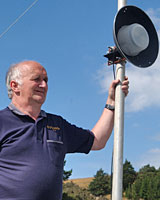UPDATE 1-Verizon Wireless kicks off mobile phone TV
Thu Mar 1, 2007 6:32 PM ET
(Recasts lead, paragraph two)
By Sinead Carew
NEW YORK, March 1 (Reuters) – Verizon Wireless, the second-biggest U.S. mobile phone provider, said it launched the country’s first commercial mobile television service in 20 states with full-length programs and picture quality similar to regular TV.
The venture of Verizon Communications Inc. <VZ.N> and Vodafone Group Plc <VOD.L> said on Thursday it is charging $15 a month for the service, which was developed by Qualcomm Inc. <QCOM.O> unit MediaFlo and includes eight channels broadcasting full-length TV shows to phones 24 hours a day.
Verizon Wireless and its rivals have been pushing services such as video and music to boost revenue as the price falls for traditional mobile phone calls.
But mobile video services have been slow to take off due to high prices and poor quality compared with television at home.
The picture quality of the new service will be on a par with home TV and roughly twice as clear as Verizon Wireless’s existing Vcast video service, spokesman Jeffrey Nelson said.
Mobile video services, first launched in the U.S. in 2004, have only about 7 million customers out of about 232 million mobile subscriptions, according to Ovum analyst Roger Entner, who said that higher-quality pictures could change that.
"I think the impact in the beginning will be modest," since Verizon is rolling out the service gradually, said Entner. But he estimated that MediaFlo users could increase to 20 million to 30 million people within about seven years.
CINGULAR TO FOLLOW
AT&T Inc.’s <T.N> Cingular Wireless, the biggest U.S. mobile service in terms of subscribers, has said it plans to launch MediaFlo to its customers later in the year.
The first phone to support MediaFlo, the U620 from Samsung Electronics Co. <005930.KS>, is being sold for $199, or $149.99 for customers who sign a two-year contract. Verizon plans to add an LG Electronics Inc. <066570.KS> phone in weeks.
Subscribers who also sign up for mobile Internet access, for $5 a month, and Verizon’s existing Vcast service, which lets users download short video clips for $15 a month, can add MediaFlo for $25 a month, or $10 less than if they were to buy the three separately.
Entner said adding eight channels for another $5 could be attractive for existing Vcast and Web subscribers.
The MediaFlo service became available on Thursday in cities such as Chicago; New Orleans; Portland, Oregon; Seattle; Las Vegas; Tucson, Arizona; Kansas City; Dallas-Forth Worth; and Salt Lake City.
Available channels include a live feed from MTV and programming from CBS Corp. <CBSa.N>, NBC, ESPN, Fox, Nickelodeon and Comedy Central. Some programs are shown at the same time as regular TV, while others are rescheduled to match the heaviest mobile phone television viewing times, Nelson said.
Viacom Inc. <VIAb.N> owns MTV, Comedy Central and Nickelodeon. General Electric Co. <GE.N> controls NBC. Walt Disney Co. <DIS.N> owns ESPN.
Wireless chipmaker Qualcomm plans to build a nationwide network for delivering television to mobile phones to kick-start the market. In that way, established operators such as Verizon can offer additional media services to customers without clogging up their own networks.
Modeo, a unit of Crown Castle International Corp. <CCI.N>, is also building a network dedicated to mobile television, but it has yet to name any customers for its service, currently in trial in New York.

 To the left: An image of a February 25 eclipse taken from NASA’s STEREO-B satellite.
To the left: An image of a February 25 eclipse taken from NASA’s STEREO-B satellite.
 Love this story about Kiwi ingenuity from the
Love this story about Kiwi ingenuity from the 